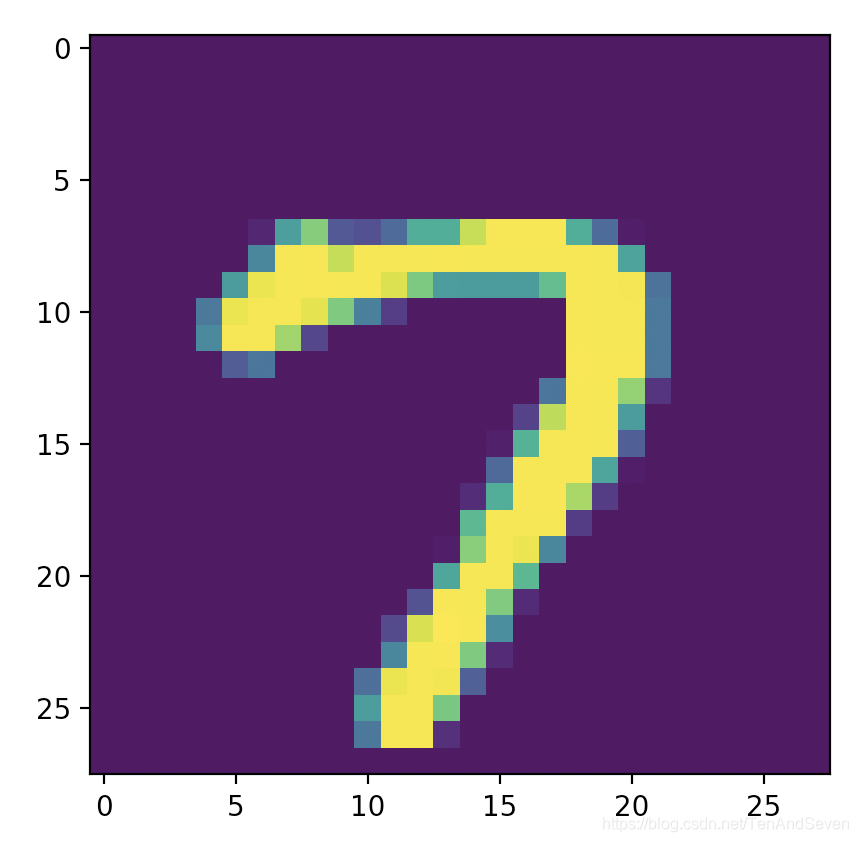代码:
import numpy as np
import matplotlib.pyplot as plt
import tensorflow.python.keras as keras
from tensorflow.python.keras import layers
from tensorflow.keras.datasets import mnist
# print(tf.__version__) -> 2.1.0
(x_train, y_train), (x_test, y_test) = mnist.load_data()
# print(np.max(x_train)) -> 255
# print(x_train.shape) -> 60000,28,28
# 归一化
x_train = x_train / 255.0
x_test = x_test / 255.0
model = keras.Sequential()
model.add(layers.Flatten(input_shape=(28, 28)))
model.add(layers.Dense(128, activation='relu'))
model.add(layers.Dropout(0.2))
model.add(layers.Dense(10, activation='softmax'))
model.compile(optimizer='adam', loss='sparse_categorical_crossentropy', metrics=['accuracy'])
model.fit(x_train, y_train, epochs=5)
res = model.evaluate(x_test, y_test) # 返回损失和精度
print(model.metrics_names)
print(res)
# 随机选取图片测试
img_random = x_test[np.random.randint(0, len(x_test))]
plt.imshow(img_random)
plt.show()
# 模型预测
img_random = (np.expand_dims(img_random, 0))
prob = model.predict(img_random)
print(np.argmax(prob))
输出:
Train on 60000 samples
Epoch 1/5
60000/60000 [==============================] - 2s 39us/sample - loss: 0.3023 - accuracy: 0.9125
Epoch 2/5
60000/60000 [==============================] - 2s 37us/sample - loss: 0.1452 - accuracy: 0.9564
Epoch 3/5
60000/60000 [==============================] - 2s 35us/sample - loss: 0.1086 - accuracy: 0.9663
Epoch 4/5
60000/60000 [==============================] - 2s 37us/sample - loss: 0.0915 - accuracy: 0.9728
Epoch 5/5
60000/60000 [==============================] - 2s 35us/sample - loss: 0.0754 - accuracy: 0.9765
10000/10000 [==============================] - 0s 26us/sample - loss: 0.0749 - accuracy: 0.9784
['loss', 'accuracy']
[0.07490696472001727, 0.9784]

7




 本文介绍了一个使用TensorFlow和Keras实现的手写数字识别模型。该模型采用了一种简单的全连接神经网络,通过5轮训练,在MNIST数据集上达到了97.65%的准确率。模型包括Flatten、Dense和Dropout层,并使用了ReLU和Softmax激活函数。
本文介绍了一个使用TensorFlow和Keras实现的手写数字识别模型。该模型采用了一种简单的全连接神经网络,通过5轮训练,在MNIST数据集上达到了97.65%的准确率。模型包括Flatten、Dense和Dropout层,并使用了ReLU和Softmax激活函数。

















 254
254

 被折叠的 条评论
为什么被折叠?
被折叠的 条评论
为什么被折叠?








